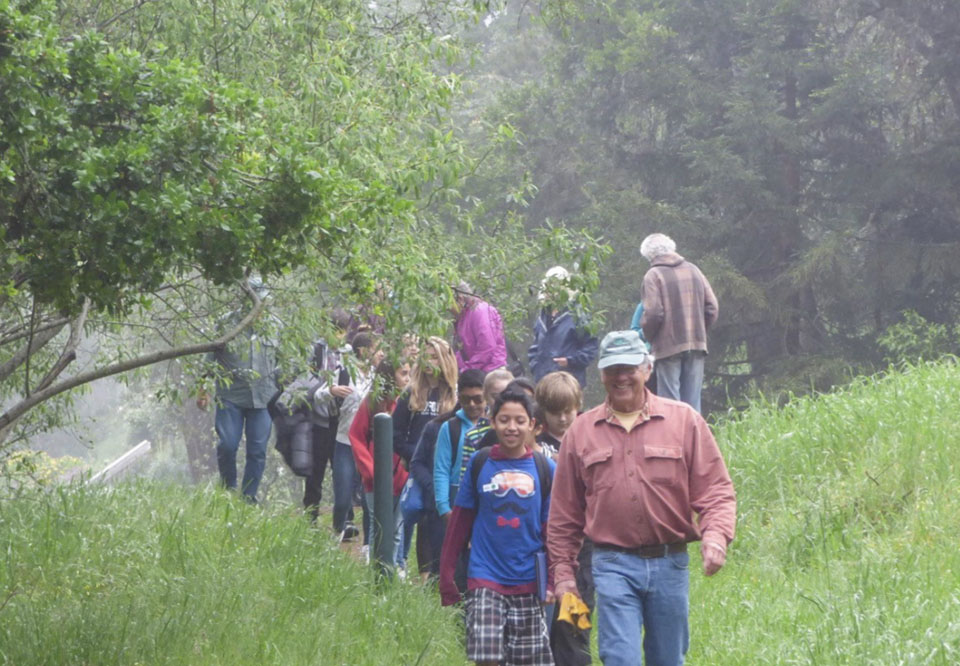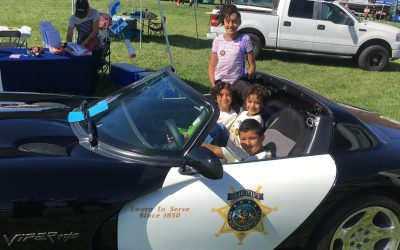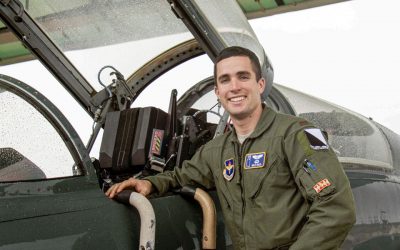Local organizations partner to connect students with nature
Students love field trips that take them out of the classroom. Greenspace’s Environmental Education Field Program connects students with nature by inviting sixth-, seventh- and eighth-grade students out into the forest as learners and researchers. It’s using nature to teach them vivid lessons about the relationships among the forest, its animals and its plants.
Led by Greenspace founder and Monterey pine forest expert Rick Hawley and under the supervision of Santa Lucia Middle School teacher Danielle Narzisi, the students spend a day in Strawberry Canyon, Greenspace’s 21 acres of rare Monterey pine forest. Only five native stands of Monterey Pine still exist, three in California and two on islands off the coast of Mexico.
This year, the program expanded to Cayucos, where seventh-grade students will study the forest during the last week of April. After two days of classroom preparation, they will visit the forest on Thursday, April 25.
Greenspace—The Cambria Land Trust and the Harold J. Miossi Charitable Trust, cosponsors the program, in its fourth year. The goal is to instill in young people the desire to protect and enhance the Central Coast’s unique Monterey Pine forest.
Greenspace board member Ann Cichowski and her husband, Robert Cichowski, Greenspace Education Program Coordinator and retired Cal Poly professor of chemistry, lead the program.
Down the forest trail
The students arrive by school bus and gather at the entrance to Strawberry Canyon. Hawley leads them down the trail to the first of five learning stations, Seeds and Insects.
“It’s wonderful to see the kids put down their cell phones and get engaged in nature,” Hawley said.
At Seeds and Insects, the students experience how a heat-treated Monterey Pine cone releases its seeds and then get to plant these seeds in germination cones. They let out a big “Yuck!” followed by a smile when they are introduced to the pine forest’s beetles, including the larva of a five-spined wood bore. As they stroll along the forest’s path, they collect insects. The insects, particularly certain beetles, can be carriers of pine tree diseases.
One budding seventh grade entomologist lifted up tree bark to find termites, bark beetles, and sow bugs, known as roly-polies. “He was totally enthralled with taking apart a dead log,” said Cichowski.
As Hawley leads them, they take note of other plants that are growing in the forest, including native poison oak. “Leaf of three, let it be!” Other native plants include dwarf mistletoe, a parasitic plant that reduces the growth, wood quality, seed production ability, and life span of the trees it infects.
“Learning some basic forest pathology facts about the Cambria pine forest is essential to understanding the forest ecosystem,” Hawley said.
Bringing their insects in magnifying boxes to the Art Station, local artists Sarah Blair Field and Art Van Rhyn give the students pointers on how to draw them.
“The kids draw just fine,” said Van Rhyn. “Mine is a small part. I just give them a piece of paper and a pencil and step back.”
Director Ann Cichowski observed that after walking through the pine forest, the students drew Monterey Pine trees as tall, slender trees with that distinctive rounded top, rather than the cone-shaped Christmas tree kids usually think of as pine trees.
“Their artwork reveals a lot about what they are learning and how they see the world,” she said.
“The kids become aware of the replenishment of the ecosystem,” said Van Ryhn. “Big things die and little things come along.”
Lunch under the pines
After Insect Art, everyone is glad to meet at the Lunch Station. The middle school students have been constantly in motion since arriving at Strawberry Canyon and now they eat and chat. Early Childhood educator Sue Davis marshals the forest’s healing powers to take the chatty tone down a notch.
“Quiet time made me relax, and I almost slept,” one wrote later. “Thank you for letting all of us calm down,” another wrote.
Soil chemistry
At the third station, Soil Testing, the students work with soil samples from planting areas in Strawberry Canyon. Cambria’s forest soil is the natural bed for the Monterey Pine. The species has occupied this part of the landscape for millennia. Primed by two days of classroom instruction, the students test the soil for pH (acidity/alkalinity), which affects pine growth. A teaspoon of soil in a measured amount of distilled water and an indicator dye tablet produces a colored solution. The color is then compared to a color chart of pH levels.
The students learn basic chemistry, how elements combine to provide important soil macronutrient levels of nitrogen, phosphorus and potassium to the trees.
Time to plant a tree
At the final learning station, Planting, they get their hands in the dirt. They plant native pine seedlings grown from seeds collected in the forest, from trees that have resisted the pitch pine canker that has infected many trees. A stake with his or her first name marks each student’s seedling. Santa Lucia 2016 sixth graders returned as seventh graders in 2017 to visit the trees they planted the year before. One student wrote, “I really liked taking a picture next to my tree.”
Back in the classroom
Back in the classroom, they spent the next two days making paper out of used, discarded paper. The new paper is used to record poems about the forest that they have created. Poet-Tree adds another dimension to the learning.
Thank-you notes follow to the Greenspace Volunteers. “I might have been in a bad mood that day, but you helped it get better,” one wrote in a thank-you, illustrated with his drawing of a red-and-green macaw. Not a native species, but listening to birdcalls is part of the field trip. The students hear jays squawking at each other, calling warnings about the people in the forest, and the hawks circling overhead, and wild turkeys gobbling.
The Santa Lucia students who were sixth-graders when they first enjoyed the program, returned as seventh graders for more advanced studies, research on the pine and oak populations as well as the dominance of dwarf mistletoe. They collected data in three transects in the forest to compare how the trees are faring.
In Fall 2018, Greenspace Environmental Education Field Program reached out to Cambria Grammar School’s fifth-grade classes. Those students are working on a seed research project to test the viability of Greenspace’s seed bank, archived seeds that have been collected for 18 years.
Videos showing the kids and the forest are posted on the Greenspace website and on YouTube.
The goal of the program is to impress on the students the importance of the relationships among all the plants and animals, large and microscopic, which support the forest ecology and foster a healthy forest.
“The wonder of it is getting out in the open, in the air, like we used to play as kids,” said Van Rhyn, now 90. “It’s very exciting for me to see the wonder of growing things that Rick (Hawley) implants in them.”
Greenspace Environmental Education Field Program is the result of a partnership between Greenspace and the Harold J. Miossi Charitable Trust, which supported the education program with a generous grant. Projects to protect the environment are one of its six program focus areas. The trust funds projects involving environmental science, green technology, promoting open spaces, sustainable agriculture, and land preservation.
“Greenspace plans to continue to expand our education outreach in the North Coast of SLO County,” said Mary Webb, president of the Greenspace board of directors. “We very much look forward to our continued partnership with the Harold J. Miossi Charitable Trust.”





